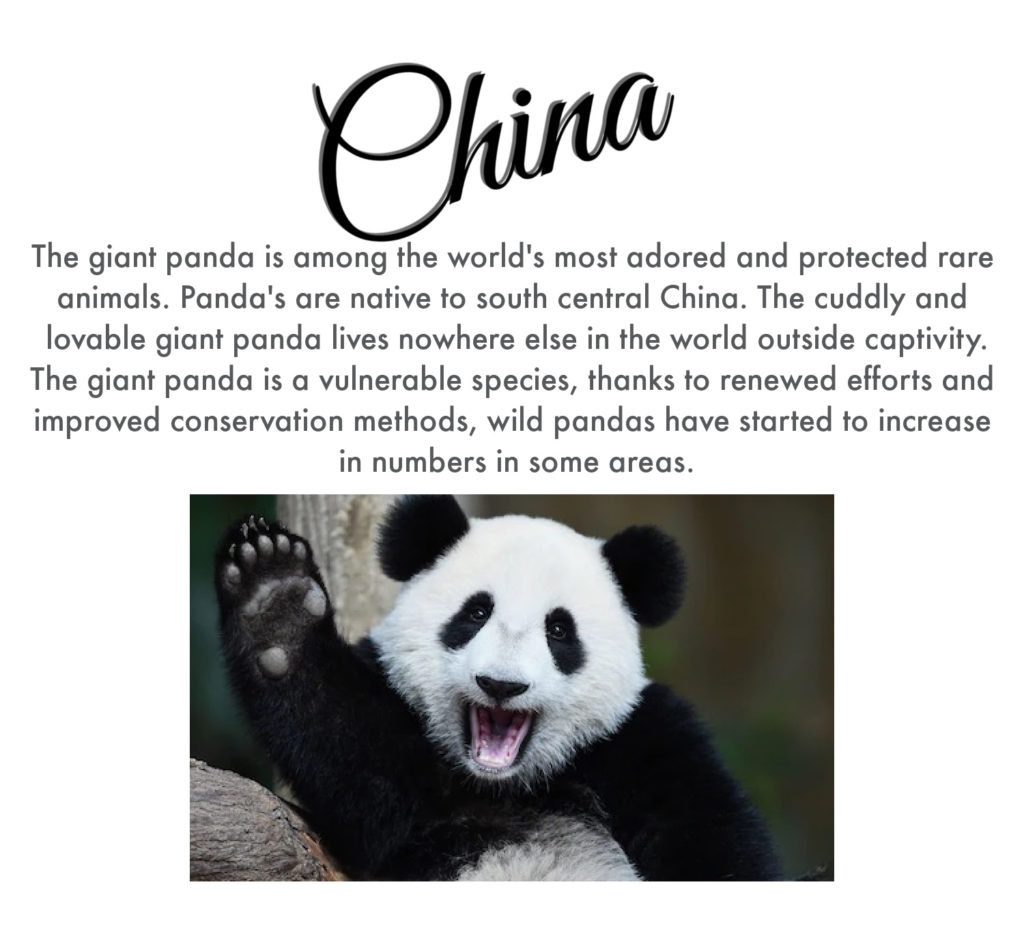Panda: 熊猫

Tiger: 老虎

As a large predator, the tiger plays a key role in maintaining healthy ecosystems. An estimated 3,900 tigers remain in the wild.
Class: Mammalia
Order: Carnivora
Family: Felidae
Genus and Species: Panthera tigris ssp. sumatrae, Panthera tigris ssp. altaica
They range across Asia from Russia all the way to the Sumatra and Indochina.
On average, tigers give birth to two to four cubs every two years.
Cubs stay with their mothers until they learn to hunt successfully, usually at about 18 to 24 months old. They reach full independence after two to three years, at which point they disperse to find their own territory. Female tigers often remain near their mother’s’ territory, while males disperse farther from home.
The largest species of cat in the world. The Amur tiger is the largest subspecies with males weighing up to 660 pounds and measuring 10 feet. Like a human fingerprint, no two tigers have the same pattern of stripes on their coats. Scientists can use these distinctions to identify tigers in the wild.
Tigers are powerful hunters with sharp teeth, strong jaws and agile bodies. They typically hunt alone and stalk prey. Tigers rely primarily on sight and sound rather than smell for hunting. A tiger can consume more than 80 pounds of meat at one time. Despite their solitary nature, communication is a very important part of tigers’ behavioral ecology. They communicate through vocalizations, such as roaring, grunting and chuffing, and through signals, such as scent marking and scratches on trees. Tigers are fiercely territorial animals, so these signals are particularly important to communicating where one tiger’s home range ends and another’s begins.
https://nationalzoo.si.edu/animals/tiger
Dragon : 龍

The dragon is also a symbol of power, strength, and good luck for people who are worthy of it in East Asian culture. During the days of Imperial China, the Emperor of China usually used the dragon as a symbol of his imperial strength and power. During festive celebrations, the dance is performed by a team of experienced dancers who manipulate a long flexible figure of a dragon using poles positioned at regular intervals along the length of the dragon. The dance team simulates the imagined movements of this river spirit in a twisting, smooth up and down dance. The dragon dance is often performed during Chinese New Year.



Great Wall : 長城
The Great Wall of China is an ancient (very old) series of walls and fortifications, totaling more than 13,000 miles in length. A long and vivid history, the Great Wall was originally conceived by Emperor Qin Shi Huang in the third century B.C. as a means of preventing attacks from barbarian nomads. Between the 18th and 20th centuries, the Great Wall emerged as the most common emblem of China for the Western world, and a symbol both physical – as a manifestation of Chinese strength – and a psychological representation of the barrier maintained by the Chinese state to repel foreign influences and exert control over its citizens. Today, the Great Wall is generally recognized as one of the most impressive architectural feats in human history. A popular claim that emerged in the 20th century holds that it is the only manmade structure that is visible from space.

Silk : 蠶絲

